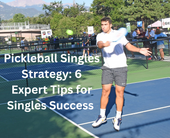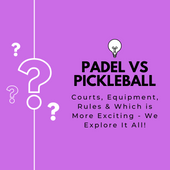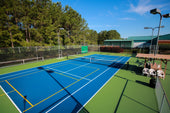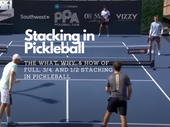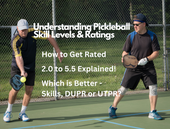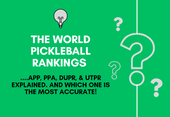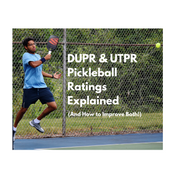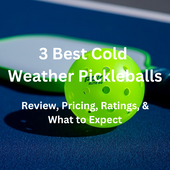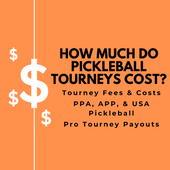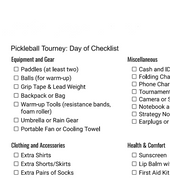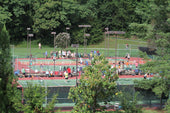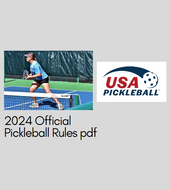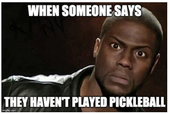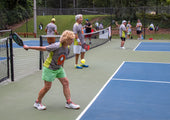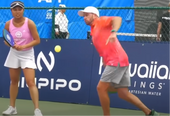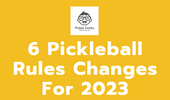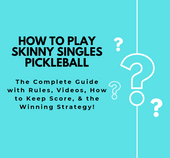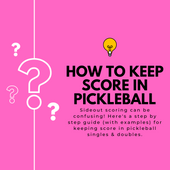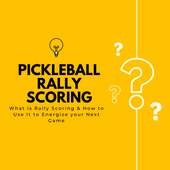A spike is a powerful and aggressive shot in pickleball that is legal in most situations.
Knowing the rules of when and where you can perform a spike, why it’s a good move, and how to effectively perform it can help you to become better and more dominant on the court!
This article will provide you with all the ins and outs of spiking the ball in pickleball, from what spikes are to when to use them and how best to hit spikes to take advantage of weak shots from your opponent.
What Is A Spike In Pickleball?
A spike in pickleball occurs when the ball is struck with a powerful overhand motion and smashed forcefully into the court on the opponent's side of the net.
A spike is performed when a player makes contact with the ball above waist level and powerfully hits or slams it downward, with force.
Here’s an example:
A spike in pickleball may also be known as a slam or a smash and is technically called an overhead shot. It’s similar to a spike in volleyball.
When performed correctly, a spike is difficult for an opponent to return! Therefore, spikes are offensive shots that can end the point or cause a miss or weak return from the opponent.
Can You Spike the Ball In Pickleball?
Yes, a spike is allowed in pickleball! However, there are some exceptions to when you can spike the ball.
For instance, pickleball has a seven-foot-deep area in front of the net called the kitchen, which is also known as the non-volley zone.
You are not allowed to spike while standing in the no volley zone.

When any part of your body is within this non volley zone (even if your toe is on the line), you are not allowed to hit the ball out of the air (either as a volley or spike).
Instead, the ball must hit the ground before you make contact with it; therefore, you cannot spike, slam or smash the ball from inside the kitchen unless the ball bounces first.
Also, spikes are not allowed on serves and are not allowed on return of serves or the 3rd shot in a pickleball rally unless the ball bounces first (this is due to pickleball's 2 bounce rule that says the 2nd and 3rd shot of a rally must be struck after the ball bounces on the ground).
Anywhere and anytime else on the court a spike is allowed!
Can You Serve Overhand In Pickleball?
No, you cannot spike a serve in pickleball. In pickleball, you must serve with an underhand motion, with the ball struck at or below your waist, and the highest point of the server’s paddle below the wrist.
In addition, the server must stand behind the service line with at least one foot on the ground until the serve is hit.

Not allowed in pickleball!
When Can You Spike In Pickleball?
Spikes are legal on any shot in pickleball except for the serve (as mentioned above, note that the 2 bounce rule in pickleball usually means players can’t spike or smash on the 2nd or 3rd shot of a rally because the ball must bounce on the ground before being struck).
If the ball bounces high enough for a player to swing with an overhand motion then spikes can be done on the 2nd or 3rd shot, as long as the ball bounces first!
Spikes, though, are usually hit when the ball is in the air and before it bounces.
A spike is usually a good option when you are at the net and your opponent hits a weak, high shot above your shoulders that you can smash downward with force.
Here's a great example of being patient to set-up a good spike option and then finishing it off with a high percentage slam at your opponent's feet:
When To Hit Spikes In Pickleball
There are two important things to remember when hitting spike shots in pickleball:
- Knowing when to spike, and
- Controlling the force of your shot.
The first is relatively simple! Spike when you are at the net and your opponent hits a high, weak shot.
If your opponent lobs and you are backing up, you may also try spike but it is a much tougher shot to execute so it’s important to not try to do too much in these situations.
Also, when spiking, it’s crucial to control the force of your hit. It’s easy to get carried away and hit the ball harder than you need to, which can lead to mistakes.
One tip when hitting spikes is to aim 3-4 feet inside the service line and sideline, so you have lots of space to burn in case of a slightly overpowered spike.
Remember, when spiking you are usually in control of the point, so the goal is to not miss! Hit a hard shot to your opponent and make them dig out of the hole they are in.
It’s likely they’ll miss the next shot or give you an easier return that you can spike again to keep up the pressure.
How To Hit An Overhand Spike In Pickleball
Spikes can be tricky to execute well! You may become so excited about the opportunity to spike the ball that accuracy, control, and technique are thrown out the window.
There are certain things you can keep in mind to increase your chances of hitting an effective spike in pickleball.
So to consistently hit good spikes, perfect your technique with the following tips:
- When the opponent hits a high, spike-able ball, move your feet and position yourself behind the ball (or where the ball will be!).
- Turn your body 90 degrees so that your shoulders and hips are facing the sideline.
- Place the paddle behind your head with your elbow cocked (your elbow should be parallel to the ground or pointed slightly toward the sky).
Try to replicate the technique and movement seen in this video:
- Once you have the technique down, focus on contacting the ball at the point where your arm is fully extended above your head when swinging, at a point 6-10 inches in front of your body.
And one final reminder - aim for precision over sheer power. Remember that a well-placed spike can be just as (if not more) effective as an extremely hard one. Focus on accuracy – not just force!
FAQs:
Do you always have to hit underhand in pickleball?
No, you do not always have to hit underhand in pickleball. You only have to hit underhand on a serve and usually on the 2nd and 3rd shots in a rally due to pickleball’s two bounce rule (the 2nd and 3rd shots can be struck overhand as long as the ball first bounces off the court) .
Why is it called a spike in pickleball?
The term spike is commonly used to describe an overhead smash because the motion is very similar to a spike used in volleyball.

In volleyball, players jump up to a high ball and use an overhead motion to smash the ball downwards with force. In pickleball, players reach their paddle up to a high ball and use a forceful overhead motion to smash the ball downward with force.
In both of these sports, spikes are offensive and aggressive shots that can be difficult for an opponent to return.





